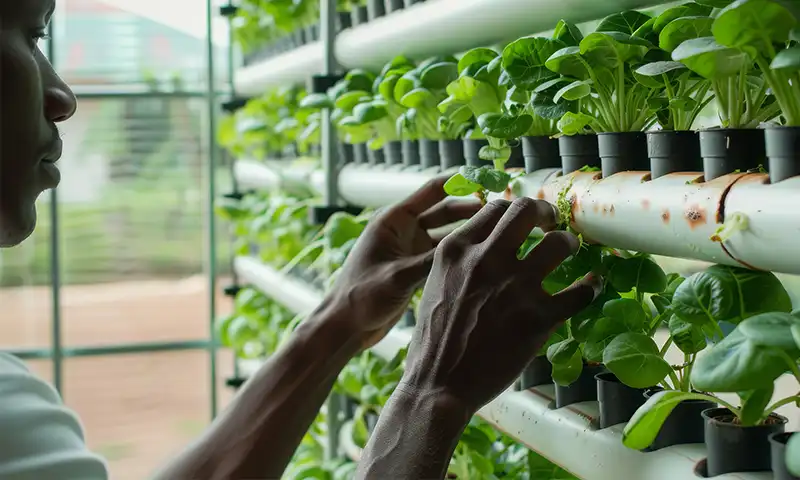Urban Farming
With the current food insecurity crisis undermining most economies, urban farming is being advanced as an alternative solution. Given the growing population in towns and the adverse effects of climate change on food production, it is increasingly important to seek better and sustainable ways of providing food where it is mostly needed. Urban agriculture, the practice of cultivating, processing and distributing food in and around city spaces, is a good option for ensuring food security in cities. In what ways can urban agriculture revolutionize addressing hunger, mitigate the ecological footprint, and strengthen the metropolitan society?
What is Urban Farming?
Urban farming is growing food in cities, which can be a small roof-top gardening, or an extensive indoor growing facility. In contrast to conventional agriculture, urban agriculture employs inventive techniques like hydroponics, aquaponics, vertical farming and other technologies that aim at optimizing space and resources. This orientation on food production eliminates the need for long transport of food extending at a food safety concern. It, therefore brings the production of food closer to consuming cities alleviating the distance food does travel and its impacts on the environment.
Urban Farming and its Role in Food Security
The increase in global population progresses side by side with an increase in food demand. However, urban farming helps address the problems of food insecurity by providing a consistent food supply within the locality. Rather than waiting for goods to be delivered from distant rural farms that may be affected by unending draughts, floods or long distances, urban farming helps in food production at the range of the consumers.
Minimizing Dependence on Lengthy Supply Chains
The minimization of supply side limitations is one of the much appreciated advantages of urban agriculture. Most urban centers get food from far off farms and that exposes them to dangers due to interferences in the supply chain. Cities do not only cut down food costs by growing their own crops, thanks to local food systems that improve food security and save on transportation.
Making Use of Overlooked Areas in Cities
Urban agriculture turns derelict parcels, rooftops, and even inclement weather structures to productive use. In common, metropolitan cities these spaces are often left neglected. With a concept of urban farming, these areas can be utilized creating vegetative cover to enhance the availability of food supplies.
The Role of Technology in Urban Farming
Urban agriculture turns derelict parcels, rooftops, and even inclement weather structures to productive use. In common, metropolitan cities these spaces are often left neglected. With a concept of urban farming, these areas can be utilized creating vegetative cover to enhance the availability of food supplies.
The Ecological Advantages of City Agriculture
City agriculture goes beyond food security purposes; it has its own environmental benefits as well. Conventional agriculture plays a big role in deforestation and erosion of soils. This is alleviated by urban farming because they grow food in the cities and there is less need for food production to that extent in the countryside. Also, urban farms can help reduce the levels of CO₂ emissions present and improve the quality of air, creating a healthier city altogether.
Enhancing the Capacity of Local Communities
The projects related to urban farming development usually include opportunities for public engagement. Urban farms can help mitigate this problem by providing the locals with skills in growing food instead of buying it from grocery shops. Gardening in the community for example, enables people to grow, and therefore increase consumption of healthy food, all the while enhancing community cohesion.
Issues Involved in Urban Farming
In spite of its merits, the practice of urban farming has its obstacles. Urban centers often have land that is costlier, and some local authorities have very restrictive regulations on agricultural practices within their jurisdiction. Even though urban farms can farm and sell fresh vegetables, they are not as efficient in producing food staples such as cereals. Overcoming these difficulties needs conducive policies, investment and further innovations.
Urban Agriculture and its Relationship with Climate Resilience
The traditional agriculture has been put to increasing risk due to adverse weather conditions caused by climate change. However, the growing trend of urban farming has the benefit of creating food in controlled environments reducing such risks, and hence, making the cities resilient to climate change. Urban farming is also beneficial in the near future by integrating green infrastructure and reducing the need hydroponics systems.
Using Urban Agriculture as a Tool for Instructional Purposes
The concept of urban farms offers a unique platform for design of educational programs. Such farms can be constructed in schools and community centers with the aim of educating children and adult populations on the aspects of growing food, etc. These lessons instill in people the importance of healthy diets as well as the importance of the impact that food purchasing decisions have on the environment.
Urban Agriculture and its Future
With the continuous growth of cities, it can be expected that urban agriculture will play even a more important role in ensuring food security. In the future, vertical farms may also be built with updated technology enabling them to produce food on a wider scale, within the cities. Given the right funding and creativity, urban farming may be one of the solutions for the eco-friendly city dweller of the future.
Conclusion: A Path Towards Food Security
With issues related to food security, urban farming proves to be a viable alternative. Emphasis on growing food locally to cut down on transport, lessen the environmental degradation, encourage community involvement, all these can help in promoting food resilience, and also help protect the environment, Urban farming practices are becoming more acceptable and embraced in these growing cities and even among the policymakers, thanks to the numerous advantages of urban agriculture; such practices may very well become a norm in every city across the globe ensuring appropriate and adequate supply of food for long.












